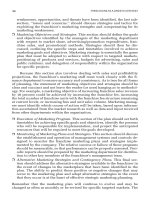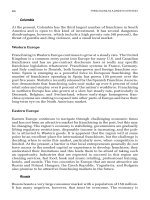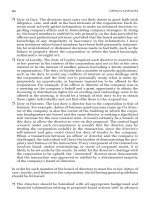Zig zag - surprising path to greater creativity
Bạn đang xem bản rút gọn của tài liệu. Xem và tải ngay bản đầy đủ của tài liệu tại đây (2.57 MB, 597 trang )
Table of Contents
Praise for ZIG ZAG
Title Page
Copyright
Dedication
Introduction: Choosing Creativity
The Eight Steps
Mistakes We Should All Avoid
How to Make Use of This Book
The First Step: ASK: How the Right
Questions Lead to the Most Novel
Answers
The Practices
Onward . .
The Second Step: LEARN: How to
Prepare Your Mind for Constant
Creativity
The Practices
Onward …
The Third Step: LOOK: How to Be
Aware of the Answers All Around
You
The Practices
Onward …
The Fourth Step: PLAY: How to Free
Your Mind to Imagine Possible
Worlds
The Practices
Onward …
Solutions
The Fifth Step: THINK: How to Have
Way More Ideas Than You'll Ever
Need
The Practices
Onward…
The Sixth Step: FUSE: How to
Combine Ideas in Surprising New
Ways
The Practices
Onward…
The Seventh Step: CHOOSE: How to
Pick the Best Ideas and Then Make
Them Even Better
The Practices
Onward …
The Eight Step: MAKE: How Getting
Your Ideas Out into the World Drives
Creativity Forward
The Practices
How Do You Know When to
Stop?
Conclusion
Learn to Choose the Right Step
Discover Your Own Style
Always Onward!
Appendix A Outline of All of the
Steps, Practices, and Techniques
Ask
Learn
Look
Play
Think
Fuse
Choose
Make
Appendix B: The Research Behind the
Eight Steps
References
Acknowledgments
About the Author
Index
Praise for ZIG ZAG
“Finally! A creativity advice book that is
grounded in scientific research.”
—Mihaly Csikszentmihalyi, author, Flow: The
Psychology of Optimal Experience
“Zig Zag is the most fun and most useful
creativity book I have ever read. Keith Sawyer's
gem sweeps you up with a host of great stories,
quizzes, exercises, and teaches you one way
after the other to be more creative.”
—Robert I. Sutton, professor of Management
Science,\break Stanford University; author, Good
Boss, Bad Boss and The No Asshole Rule
“In geometry the shortest distance between two
points is a straight line. But in creative pursuits,
Zig Zag shows us, it's anything but. Keith
Sawyer is the most creative person writing
about creativity I know.”
—Robert Mankoff, cartoon editor, The New
Yorker; author, The Naked Cartoonist: A New Way
to Enhance Your Creativity
“Creativity is essential in our journey to the
future, and this gem of a book helps each of us
on the way.”
—Tim Brown, CEO and president, IDEO; author,
Change by Design: How Design Thinking
Transforms Organizations and Inspires
Innovation
“Keith Sawyer is the best combination of a
brilliant creativity researcher and storyteller
around.”
—Peter Sims, author, Little Bets: How
Breakthrough Ideas Emerge from Small
Discoveries
“Zig Zag reveals the true nature of the creative
process: improvisational, surprising, with
unexpected twists and turns. The book is filled
with hands-on activities that help you manage
that process and keep it moving forward to a
successful creative outcome.”
—Josh Linkner, author, Disciplined Dreaming: A
Proven System to Drive Breakthrough Creativity
Cover design by John Hamilton
Cover image: © Alicat/iStockphoto
Copyright © 2013 by Keith Sawyer. All rights
reserved.
Published by Jossey-Bass
A Wiley Imprint
One Montgomery Street, Suite 1200, San
Francisco, CA 94104-4594—
www.josseybass.com
No part of this publication may be reproduced,
stored in a retrieval system, or transmitted in any
form or by any means, electronic, mechanical,
photocopying, recording, scanning, or otherwise,
except as permitted under Section 107 or 108 of
the 1976 United States Copyright Act, without
either the prior written permission of the publisher,
or authorization through payment of the appropriate
per-copy fee to the Copyright Clearance Center,
Inc., 222 Rosewood Drive, Danvers, MA 01923,
978-750-8400, fax 978-646-8600, or on the Web
at www.copyright.com. Requests to the publisher
for permission should be addressed to the
Permissions Department, John Wiley & Sons, Inc.,
111 River Street, Hoboken, NJ 07030, 201-748-
6011, fax 201-748-6008, or online at
www.wiley.com/go/permissions.
The collaborative sketching figure in Chapter 8 is
adapted from figure 2 on page 170 of; Shah, J. J. et
al. (2001). Collaborative sketching (C-Sketch).
Journal of Creative Behavior, 35(3), 168– 198.
Copyright © Wiley; reprinted with permission.
Limit of Liability/Disclaimer of Warranty: While
the publisher and author have used their best
efforts in preparing this book, they make no
representations or warranties with respect to the
accuracy or completeness of the contents of this
book and specifically disclaim any implied
warranties of merchantability or fitness for a
particular purpose. No warranty may be created or
extended by sales representatives or written sales
materials. The advice and strategies contained
herein may not be suitable for your situation. You
should consult with a professional where
appropriate. Neither the publisher nor author shall
be liable for any loss of profit or any other
commercial damages, including but not limited to
special, incidental, consequential, or other
damages. Readers should be aware that Internet
Web sites offered as citations and/or sources for
further information may have changed or
disappeared between the time this was written and
when it is read.
Jossey-Bass books and products are available
through most bookstores. To contact Jossey-Bass
directly call our Customer Care Department within
the U.S. at 800-956-7739, outside the U.S. at 317-
572-3986, or fax 317-572-4002.
Wiley publishes in a variety of print and electronic
formats and by print-on-demand. Some material
included with standard print versions of this book
may not be included in e-books or in print-on-
demand. If this book refers to media such as a CD
or DVD that is not included in the version you
purchased, you may download this material at
. For more
information about Wiley products, visit
www.wiley.com.
Library of Congress Cataloging-in-Publication
Data
Sawyer, R. Keith (Robert Keith)
Zig zag : the surprising path to greater creativity /
by R. Keith Sawyer, Ph.D.
pages cm
Includes bibliographical references and index.
ISBN 978-1-118-29770-4 (cloth), 978-1-118-
53911-8 (ebk.), 978-1-118-53922-4 (ebk.),
978-1-118-53926-2 (ebk.)
1. Creative ability. I. Title. II. Title: Zig zag.
BF408.S288 2013
153.3′5— dc23
2012042028
first edition
To my son, Graham
Introduction
Choosing Creativity
Ineffective people live day after day
with unused potential. They experience
synergy only in small, peripheral ways
in their lives. But creative experiences
can be produced regularly,
consistently, almost daily in people's
lives. It requires enormous personal
security and openness and a spirit of
adventure.
Stephen Covey
Creativity doesn't always come naturally to us.
By definition, creativity is something new and
different; and although novelty is exciting, it can
also be a little scary. We're taught to choose what's
familiar, to do what's been done a thousand times
before. Soon we're so used to staying in that well-
worn rut that venturing into new terrain seems an
enormous and risky departure.
But rest assured—you already have what it takes
to be creative. Neuroscience and psychology have
proven that all human beings, unless their brain has
been seriously damaged, possess the same mental
building blocks that inventive minds stack high to
produce works of genius. That creative power you
find so breathtaking, when you see it tapped by
others, lives just as surely within you. You only
have to take out those blocks and start playing with
them. How, though?
In fact, the journey's pretty simple. In this book, I
share with you the eight steps that are involved in
being creative. Once those steps become second
nature to you, creativity won't seem rare and
magical and daunting. You'll stop being scared of
writer's block or stupid ideas or a blank canvas or
a new challenge, and your creative power will be
flexible, versatile, and available in unlimited
supply. All you have to do is learn how to tap it.
And that's the purpose of the exercises in Zig Zag.
I started thinking about creativity many years
ago, when I graduated from MIT with a computer
science degree and found myself designing video
games for Atari. Since then I've played jazz piano
and studied how jazz musicians collaborate;
earned a doctorate in psychology at the University
of Chicago and studied how Chicago's improv
companies create on the spot; researched theories
of creativity in education; and studied how artists
and sculptors teach creativity.
No matter what kind of creativity I studied, the
process was the same. Creativity did not descend
like a bolt of lightning that lit up the world in a
single, brilliant flash. It came in tiny steps, bits of
insight, and incremental changes.
Zigs and zags.
When people followed those zigs and zags,
paying attention to every step along the way, ideas
and revelations started flowing. Sometimes those
ideas did feel like gifts, arriving unsolicited at the
perfect time. But in reality, a lot of daydreaming,
eclectic research, wild imagination, and hard
choices had paved the way.
The creative act is nonlinear.
Josh Linkner, jazz musician and
entrepreneur
It's lucky we do all have creative potential,
because we need it more than we realize. You
might think of creativity only in a single context, as
a quality you pull out when it's time for a weekend
craft project or a crazy practical joke. But you can
use creativity to
Excel at your job
Build a successful career
Balance professional success with a deeply
fulfilling personal life
Shape your personality, your sense of style,
the way you connect with the world, and the
way you are perceived
Raise your children without dull routines,
harsh words, or quick-fix bribes
Learn effectively—not by rote memorization,
but in a way that makes the knowledge part of
you, so you can build on it
Find fresh, clever, permanent solutions to
nagging problems
Make good and thoughtful decisions
Forge interesting, sustaining friendships
Bring about real change in your community
Think of a challenge, need, or issue that you face
right now. Something that you care about and just
don't know how to deal with; something that is
frustrating you or feels like an impasse. Scribble
this challenge on a Post-it note (now there was a
creative product idea!) and stick it to this page.
Scribble a few more, if you like; you can plaster
the page with them.
Here are some examples that most of us have
faced at some point in our lives:
“My career is stuck, and I don't know how to
move forward.”
“My relationship seems to be falling apart,
and I don't know what's wrong.”
“I'm spending way more money than I'm
making.”
At your job, your problem might be more
immediate and concrete:
“I need a good idea for my next advertising
campaign.”
“My company wants to market our successful
product to a new type of customer, and we're
not sure how we need to change the product to
satisfy them.”
“I need a way to explain the latest changes in
tax policy to our employees.”
“My group doesn't work together very well
because no one understands what anyone else
is doing.”
“At my medical practice, we're starting to get
a lot of patients with the same disorder, and I
can't figure out why.”
In many professions, the problems can get so
specific and so technical that only you know how
to phrase them. As a psychology professor, I face
challenges like the following:
“How can I rewrite my scientific journal
article so it's readable enough for a general
audience?”
“I need a research project compelling enough
to win a National Science Foundation grant.”
“My students didn't understand a word of the
reading I assigned. I need a clearer, livelier
way to teach them this material.”
As you read the techniques in this book, keep
thinking of your Post-it challenges, and play with
these techniques to find a creative solution.
The Eight Steps
I've spent more than twenty years as a research
psychologist studying how creativity works. I've
explored the lives of exceptional creators and
learned the backstories of world-changing
innovations. I've reviewed laboratory experiments









